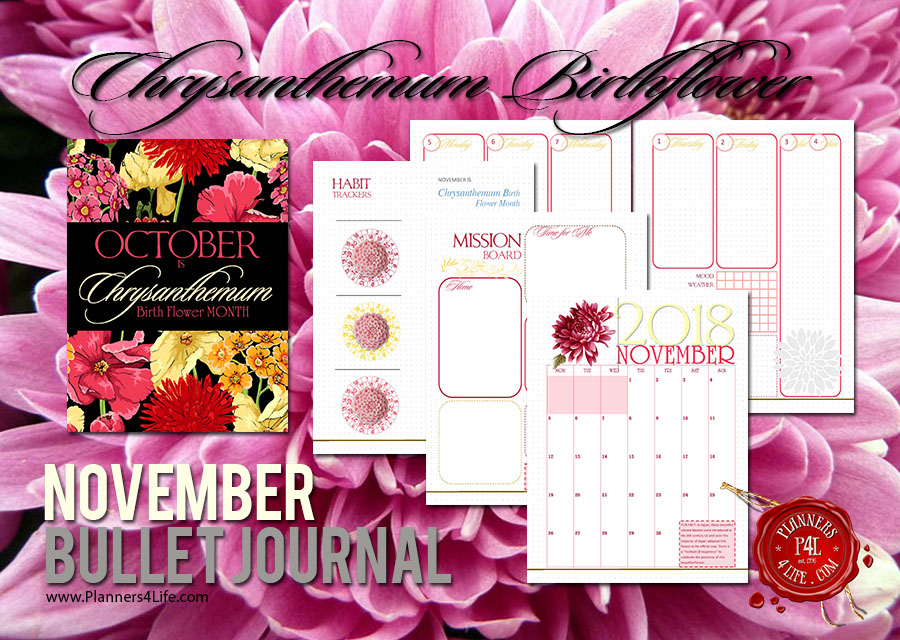
NOVEMBER IS Chrysanthemum BirthFlower
The chrysanthemum is the November birth flower. Chrysanthemums were first cultivated in China many centuries ago, and have appeared in ancient Chinese writings since 15th century BC. The Chinese used the chrysanthemum as an herbal remedy for various ailments such as headache relief, reducing blood pressure and as an anti-inflammatory.
From China, the chrysanthemum migrated across the sea to Japan where it was further cultivated by Buddhist monks in AD 400. Due to its beauty, the flower quickly became the official flower for the Japanese emperor’s crest and official seal. The Japanese word for chrysanthemum is “kiku” and every year the country celebrates National Chrysanthemum Day, which is also referred to as the Festival of Happiness.
The chrysanthemum finally made its way over to Europe in the 17th century where Carl Linnaeus, the father of taxonomy, coined the name “chrysanthemum.” The name is a fusion of the words “chrysos” meaning gold, and “anthemon” meaning flower. Today, this November flower has become one of the most popular flowers around the world.
Chrysanthemum Meanings and Symbolism,
Chrysanthemums come in a variety of different colors, each holding a different meaning:
- White chrysanthemums symbolize loyalty and honesty.
- Red chrysanthemums symbolize love and deep passion.
- Violet chrysanthemums symbolize a wish to get well.
- Yellow chrysanthemums symbolize neglected love or sorrow.
The Chrysanthemum, which is closely related to the daisy is often referred to by cultivators and gardeners as "mums". It currently includes about 30 species of perineal flowering plants which are native to Asia and northeastern Europe. At one point there were more species of the Chrysanthemum but the species was split.
The Chrysanthemum can grow between 50-150cm tall, has deep leaves and large flower heads with dozens of petals. The Chrysanthemum is most commonly found in shades of white, pink, red and yellow.
In parts of Asia the Chrysanthemum petals are boiled in order to make a sweet drink known as Chrysanthemum tea. It is believed that this tea has many medicinal uses including curing influenza.
The Chrysanthemum resembles a close cousin the mugwort weed which is often called the wild Chrysanthemum. Because of this many florists do not like to use the Chrysanthemum in floral arrangements. In some countries in Europe and in Japan, Chrysanthemum's are the symbol of death and only used in funeral arrangements, while the opposite is true in America where it is seen more as positive and cheerful.
Fun and interesting fact:
An ancient Chinese city was named Chu-Hsien, meaning "chrysanthemum city". The flower was introduced into Japan probably in the 8th century CE, and the Emperor adopted the flower as his official seal. There is a "Festival of Happiness" in Japan that celebrates the flower.
Chrysanthemums or “mums” as they are more commonly known are one of the most widely cultivated flowers in the world, and the birthday flower for those born in the month of November. A native to Asia and northeastern Europe, their name comes from the Greek words “chrysos,” meaning gold, and “anthemon,” which means flower. They are a member of the daisy family, which also includes asters, zinnias and coneflowers. Many varieties of chrysanthemums bloom during the fall months; however, you can also find chrysanthemums blooming just about any time of the year.
What makes these plants so interesting is the diversity of flower variations you can find. From puffy poms to the spindly spider and quill flowers, there is a chrysanthemum for every taste. Plants feature dark green leaves and relatively large flowers, with the most common colors being yellow, pink, red or white. Contrary to their appearance, the chrysanthemum’s pom blooms are not just one single large flower, but rather a grouping of many tiny flowers.



